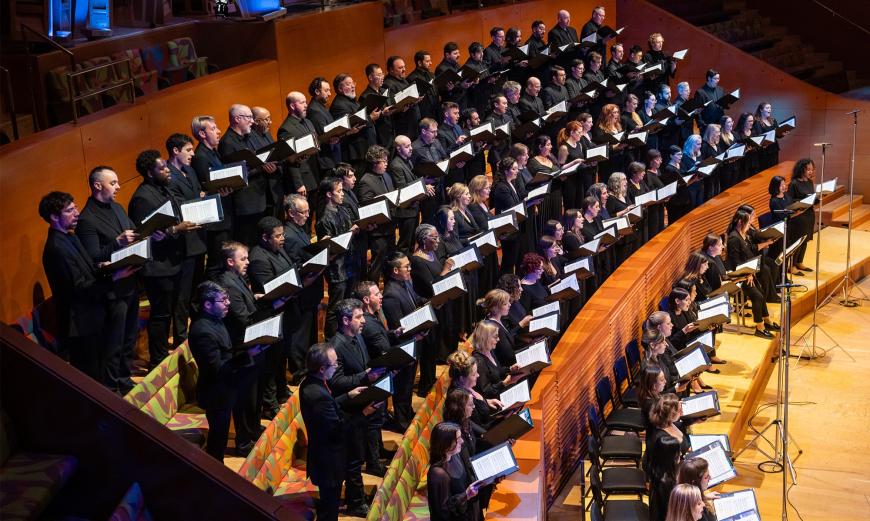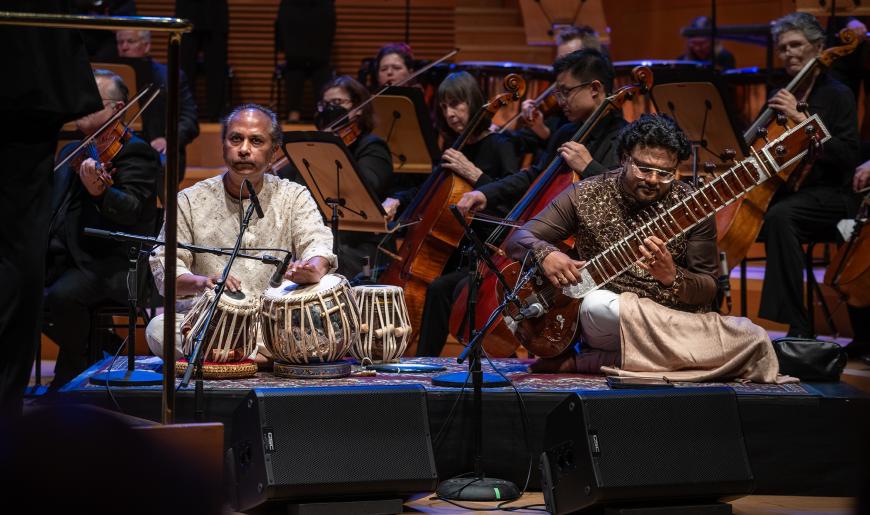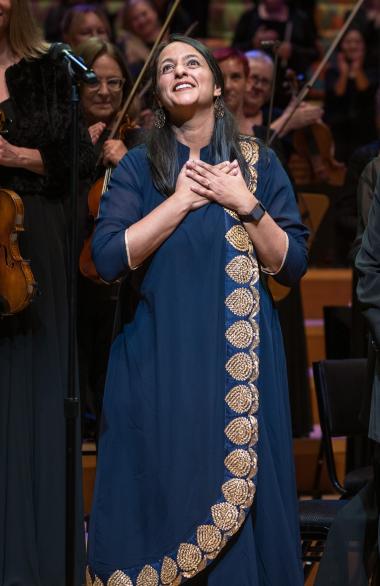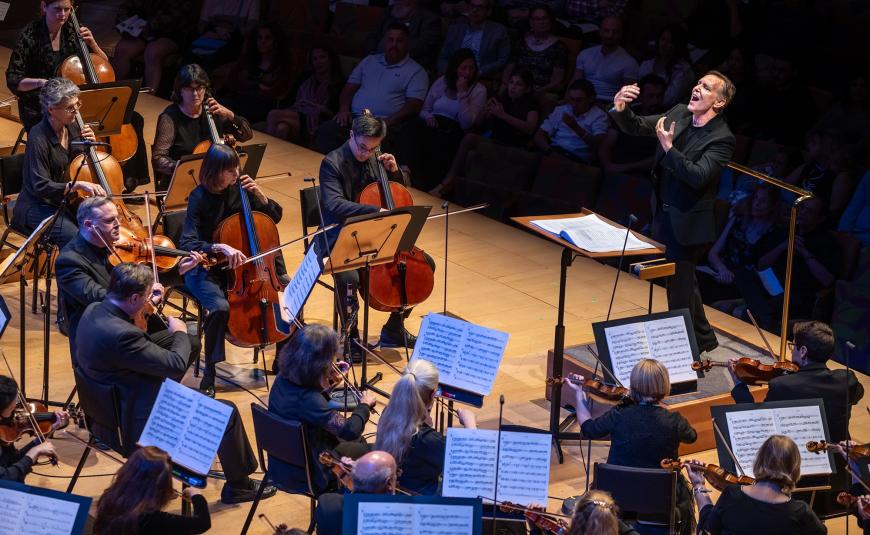
The Los Angeles Master Chorale’s season-opening concert at Walt Disney Concert Hall on Sunday, “Heaven + Earth,” was in every way a grandly scaled event. It featured 200 singers and musicians, sitar and tabla soloists, and texts that required the Master Chorale to sing (in addition to Western harmonies) in the rhythms and microtonal vocal traditions of India and its local dialects, as well as the indigenous language of the South American Guaraní people.
Led by Artistic Director Grant Gershon, the concert began with a reprise performance of Reena Esmail’s This Love Between Us: Prayers for Unity, which was given its West Coast premiere by Gershon and the Master Chorale in 2018. Composed when Esmail was a doctoral candidate at Yale University, the work is an East-West fusion, combining religious texts from India’s seven major religions with the European Baroque orchestral-choral tradition. At heart, it is a gentle piece that pleads for a more humanitarian approach to our violent, overly divided world.
The second half of the program was also a reprise, devoted to the vast ebb and flow of Philip Glass’s 1989 symphonic portrait Itaipú, which Gershon conducted with LAMC in 2001 as part of his inaugural concert as music director.

The magnitude and impact of the concert was undeniable, as was its critical message of religious tolerance. Unfortunately, it was also a performance marred by a technical difficulty.
During a preconcert conversation, Gershon mentioned the necessity of amplifying the sitar and the tabla in Esmail’s piece (played by Rajib Karmakar and Abhiman Kaushal, respectively) in order to balance them with the orchestra and chorus. But as he conducted the first two movements of the seven-movement composition, Gershon was unaware that the amplification was off, making Karmakar’s and Kaushal’s performances totally inaudible. It wasn’t until an audience member pointed out the problem that the performance was stopped and the issue corrected with the flip of a switch.
“Sometimes it’s the simplest things,” Gershon quipped, trying to make the best of a bad situation.
If the problem had been pointed out earlier, LAMC could have begun again. But because of time constraints, Gershon was forced to pick up where the ensemble had left off. To the credit of the singers and musicians, the mistake was more or less successfully overcome.

Esmail’s choral writing in this work soars angelically with a hopeful degree of optimism in the human race’s capacity for compassion — which, at the moment, seems in disastrously short supply. The piece’s blending of Eastern and Western classical traditions was skillfully expressed by the vocal soloists: soprano April Amante, mezzo-soprano Lindsay Patterson Abdou, tenor Joey Krumbein, and bass Chung Uk Lee.
Glass was at the height of his compositional powers when Itaipú had its premiere with the Atlanta Symphony, conducted by Robert Shaw. Previously, Glass had depicted a world out of balance in his score for Godfrey Reggio’s 1982 cinematic masterpiece Koyaanisqatsi. With Itaipú, Glass’s intent was to create a symphonic work that would celebrate human technology as in tune with the natural world. His inspiration was the recently completed 5-mile-long Itaipu Dam on the Paraná River between the borders of Brazil and Paraguay — at that time the largest hydroelectric dam in the world.
To represent the dam’s size, Glass composed his score for a 100-piece orchestra and a large chorus. He divided the work into four movements that flow together: “Mato Grosso,” “The Lake,” “The Dam,” and “To the Sea.” For text, he incorporated the creation myths passed down by the Guaraní people.
Though Glass commissioned a translation from Brazilian film director Daniela Thomas, LAMC didn’t provide it. Seeing the poetic text would have allowed an inroad into the piece’s meaning. Without any translation, Guaraní mythology was reduced to a succession of indecipherable, though fascinating, phonemes.
Gershon described the work as “maximal minimalism,” and it’s an apt description. Itaipú is minimalist in its reliance on a consistent pulse and complex, slowly changing ostinato patterns. These features are complemented by the magnitude of the orchestration and the choral writing. Glass’s music is incredibly challenging to play, especially for the string players forced to finger arpeggio after arpeggio after arpeggio in 12/8 time. In addition, the music requires a degree of synchronization to create a groove of forward momentum, like the surging river it depicts.

That groove took quite a while coming Sunday. But once it did, the performance was overpowering. There were jungle shadows in the low strings’ depiction of the river’s origins in the “land of surging waters.” Glistening phrases in the strings and birdlike calls in the winds represented the river slowing and expanding into a great lake. A low rumble in the timpani mirrored the mighty turbines, powered by vocal writing that rose to a torrent.
In the final movement, the river fulfills its destiny, making its way to the sea, where its waters blend in a disappearing diminuendo as the chorus intones a soft summation.




